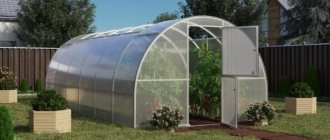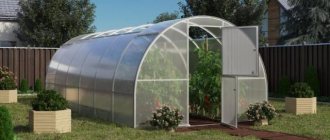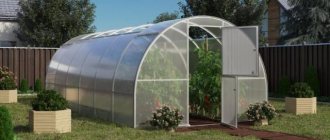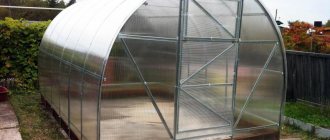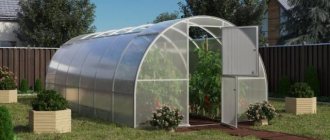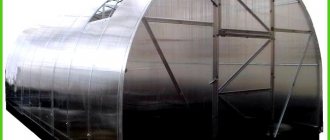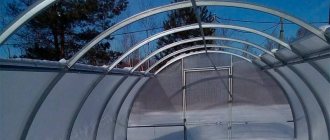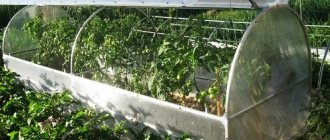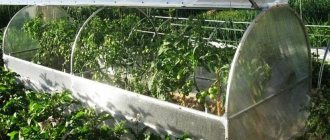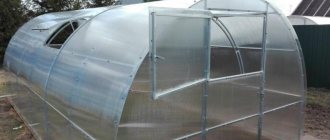Today we will conduct a comparative review of new greenhouses with a sliding roof and with opening sides.
For comparison, we have selected eleven of the most popular greenhouses with an opening top on the Russian market:
- Marusya
- Tulip
- Kremlevskaya-Rublevskaya
- Orion
- Delta
- Flora-Cabriolet
- Nurse-Clever
- Assistant-Gardener
- Sesame
- Sim-Sim
- Gift
Comparison information is taken from manufacturers' official websites and verified consumer reviews.
All greenhouses will be sorted in ascending order by cost of a 6-meter long frame for the period January 2022. Some models cannot be installed without a foundation, so we have added the cost of a foundation or lugs to the price.
So, let's move on to our competitors.
Greenhouse "Marusya"
, Moscow Plant website: https://greenhouses-from-polycarbonate.rf No foundation required. Square profile 40x20 and 20x20 mm. Frame price 6m 24,900 rub.
Advantages: Produced since 2016, during this time several upgrades have been made. It is equipped with Premium polycarbonate 4 mm, density 0.7 kg/m2 with effective UV protection on the surface, service life 15 years. The width of the expanding polycarbonate sheet is 1 meter; if desired, it can be reduced to 65 centimeters. The frame does not rust, is made of galvanized square pipe. The design allows the installation of automatic vents. Inexpensive, repairable polycarbonate guides with UV protection. Collapsible, convenient for transportation.
Disadvantages: Difficulty in self-installation.
Installation subtleties
When installing a greenhouse, you need to decide whether it will be mounted on a concrete base or whether it is better to do without a foundation at all. If you build without a foundation, insects and rodents, like weeds, will have no obstacles in their path and can easily get inside. Although, using one trick, it is still possible to compensate for this shortcoming. In addition, some of the heat that accumulates inside will inevitably be lost. If the greenhouse is used only in the summer season, there is no need to worry about its losses. Wasted solar energy is not a waste of electricity, on which money was spent.
Many people prefer not to complicate matters by installing a foundation. This costs both time and money. Not everyone is ready for them. In addition, to install a greenhouse without unnecessary problems with a solid base, a few warm days will be enough. When moving a building to another location, you do not need to think about how to dismantle the remaining foundation.
When installing, it is necessary to take into account the type of soil. To understand what it is like, you need to dig a hole half a meter wide to a depth of just over one meter. It remains to determine what kind of soil is between 20–80 centimeters from ground level. If it is sand, it will be slightly damp and crumbly (you cannot make anything out of it), this type of soil will be the best base for a greenhouse. Water will not linger in it for a long time, and the roots of planted vegetable crops will not rot.
If the soil is clayey, you will have to make a small pit to a depth of half a meter. You can pour sand into it from a river or a special quarry, but not to the very top, but so that there is enough space to fill the fertile layer, which also needs to be immediately brought and leveled on the site. If there was water at the bottom of the hole dug to determine the type of soil, it is better to dig recesses around the future structure to drain the liquid. All these measures will help avoid a situation where effort and money are spent on purchasing and installing a greenhouse, and the harvest is lost.
For installation, you can choose days at the end of the gardening season, when the area is cleared of vegetation, or in the spring, when the time has not yet come for planting vegetable crops.
The most favorable installation time is at a temperature of about ten degrees Celsius. Under such conditions, cellular polycarbonate bends best. It will not break, as happens in cold weather, and will not expand if it is fixed at a higher temperature.
Instructions for assembling a greenhouse without a special base are as follows:
- first, a platform is prepared for it, the lower trim with protrusions in the shape of the letter “T” is assembled on it, with which the structure can be “anchored” in place;
- then the above-ground part of the frame is mounted, polycarbonate panels are installed, and the windows, doors and ends of the “greenhouse house” are lined.
The area for the greenhouse is allocated with a margin of one meter from the actual parameters of the selected factory option. The height difference on it can be within five centimeters. A trench is dug around the perimeter so that supports in the shape of the letter “T” fit into it. In this case, only ten centimeters of the lower part of the frame should protrude above the ground line after installation. The bottom of the recess is compacted, the horizontal parameters are measured so that in the future there is no need to make supports for the corners of the greenhouse.
To protect greenhouse “residents” from weeds, the outer wall of the trench should be covered with sheets of slate or roofing material that have not found any other use on the farm. To assemble the “skeleton” of the greenhouse itself, you will need a screwdriver and a wrench. The complete set of components from which the base is assembled includes both the fastening elements themselves and the diagram according to which all parts of the structure are connected. To build a frame for installing polycarbonate, you first need to assemble the end parts of the greenhouse, attach door frames with vents and reinforcing strips to the arches (although the end parts are sometimes sold ready-made). This is all bolted to the bottom trim and then the legs are attached to it in a "T" shape.
The part of the structure that will be underground must be coated with bitumen. Then the ends should be installed in the trench and the entire frame should be assembled according to the instructions. Install walls made of polycarbonate sheets. If the kit includes automatic windows, install them too. The gap between the installed greenhouse and the ground line must be filled with soil to a height of 3–5 centimeters and additionally covered with a metal or opaque polyethylene strip, which will protect the planted crops from insect attacks.
Greenhouse "Orion"
, Dubna Official website: https://teplica.lobachev.org No foundation required. Profile pipe 40*20 mm. Price 3*6m – 26,700 rub.
Advantages: Has been in production for over 7 years, has good user reviews. We offer branded polycarbonate 4 mm "Volya Premium Garant" with a density of 0.7 kg/m2, service life 15-20 years. Rubber seals included. The width of the sliding part is 1 meter. Galvanized. Polycarbonate guides. Collapsible, easily fits in a car.
Disadvantages: Difficulty in self-installation.
Greenhouse "Flora-Cabriolet"
, Vladimir region. Factory website: https://7teplic.ru The frame is galvanized or painted. Profile 20 mm. The roof is removable. A foundation is required. The frame costs 28,000 rubles. + foundation for 4500 rubles = 32500 rubles.
Advantages: Straight walls – more usable area. You can order a galvanized frame.
Disadvantages: The painted frame will rust over time. Welded, welding seams rust. High walls have greater windage. Bulky, inconvenient to transport in a car. Not convenient to use. The edges of the removable roof are located at a height of 2 meters, making it difficult for short people to use. Before winter, it is necessary to completely remove the roof and put it away, and in the spring, insert a long three-meter sheet into the guides in place; this requires two tall people and a free space of 2-3 meters on one side. The length of the polycarbonate sheet on the roof is 3 meters; you need to have a free space of 2-3 meters on one side to use it. In summer, the sheets cannot be extended more than 20 cm, otherwise the wind will fray the free ends and may even tear them out of the guides or break them. There are no seals, the heat will escape through the cracks. The kit does not include high-quality, durable polycarbonate. Greenhouses “Flora Cabriolet” are equipped only with cheap polycarbonate from the KS Profplast plant without UV protection on the surface in the form of a film, but only “in bulk”. Such polycarbonate can be destroyed by the sun within 5 years. The walls are covered with weak, “lightweight” polycarbonate with a reduced density. Difficulty in self-assembly.
Design characteristics
The skeleton of the structure is made of galvanized profile pipe. Polycarbonate, whose thickness ranges from four to six millimeters, is tightly connected to the arches and cross bars. This is a feature of the so-called “Crab” system, which allows you to distribute the external load evenly over the entire area of the walls. The walls themselves move easily and are fixed at the desired height in this sliding structure thanks to convenient guides. They can be raised and lowered in separate sections.
The width of the “house for plants” is three meters, the height is just over two meters. The length can be chosen depending on the scale of the landowner’s plans for the future harvest. There are options for greenhouses from four to ten meters in increments of two. Doors are provided at the ends of the insulated house for vegetable crops. Each is equipped with a window. The width of the doors is about one meter, which allows a garden wheelbarrow to pass through them freely.
Thanks to the “Tulip” device, you can serve greenhouse crops both from the inside and from the outside - just move the wall to conveniently collect fruits from the “outside” side of the bush or, for example, remove stepsons.
Greenhouse Botanist “Tulip Antistorm 2021”
Production: "AGS-Service", Republic of Belarus Website: https://ags-agro.by Top and sides move apart. Installed on the foundation. Profile 40x20 mm. The cost of a frame 6m long is 41,700 rubles.
Pros: Opening top. Galvanized.
Disadvantages: Large windage of 2-meter sliding polycarbonate sheets. Polycarbonate is a soft, elastic material, with such windage it can be torn out by a gust of wind. There are no rubber seals around the cracks through which heat escapes. In winter, snow gets into the cracks between the opening roof and the sides, bursts the polycarbonate and squeezes it out of the guides.
When installed without a foundation, on piles, due to large spans, skew and polycarbonate may fly out of the guides.
The guides are made of plastic containing various additives, vinyl chloride, which upon contact destroy polycarbonate over several years. Factories prohibit contact of polycarbonate with PVC, and you lose the warranty from the SPK manufacturer. Difficult to install. The profile guides are not transparent, the frame is not visible through them, which makes it difficult to secure them with a self-tapping screw exactly in the center and the sliding elements get wedged as a result. Thick plastic guides and metal frame have different coefficients of thermal expansion. In winter, the plastic loses elasticity in the cold and becomes rigid, the guide pulls the screw out of the metal and, as a result, gaps form between the frame and the guides.
Expensive replacement of guides in case of breakdown; they can only be purchased from the manufacturer in Belarus; in Russia, greenhouse sellers currently do not sell guides separately. Bulky, inconvenient to transport in a car.
Pros and cons of the product
Advantages of the Tulip greenhouse based on the manufacturer’s data and the opinions of gardeners:
- The ability to open up. Sliding sides and top. Availability of using rain for irrigation. Easy plant care.
- Good temperature indicators (much depends on the quality of the coating).
- Possibility to choose the length of the structure.
- Eliminating the problem of snow load in winter. Natural insulation and enrichment of the soil with snow.
- Well thought out air exchange and ventilation.
- Detailed assembly instructions.
Cons of a greenhouse:
- high price;
- complaints about the service of certain domestic dealers;
- difficult control of moving elements during the first time of using the greenhouse;
- lack of declared resistance of Antistorm models to gusts of wind.
The Tulip greenhouse is a new, fashionable, but not fully tested product. TM Botanik focuses on this design. It has competitive advantages. However, there are a number of shortcomings. The current model of the Belarusian manufacturer is probably not the last, and will be improved in the future.
Greenhouse "Sim-Sim"
Produced by Greenhouses of the North LLC, Cherepovets. In 2020, the plant stopped producing this model. A copy of the Sesame and Tulip greenhouses with all their shortcomings. Installed on the foundation. The width of the transoms is 2 meters. There are two options: The first is from a 40x20 mm profile. Copied from the Tulip greenhouse. The second is made from a 20x20 mm profile with a double arc, a copy of the “Helper-Gardener” and “Sesame” greenhouses. In 2022, a 6-meter frame cost 25,100-27,000 rubles. + foundation made of timber 3000 rub. + you need to buy lugs for the timber (at least 1 piece every 2 meters).
The same as for all greenhouses with opening sides. Large windage, loose polycarbonate sheets are torn out of the guides by strong winds, and in winter they are also squeezed out by snow.
To reduce the final cost of the Sim-Sim greenhouse, the Greenhouses of the North plant equips its frames with cheap, lightweight, 0.55 kg/m2 density, without UV protection on the surface, 4 mm polycarbonate. Such polycarbonate with so-called UV protection “in bulk” can begin to deteriorate after just three years. Complex and time-consuming assembly. There are no rubber seals around the gaps through which heat is blown out. “Crab system” for attaching pipes (it becomes loose over time). The guides are made of plastic and may begin to crumble after a few years when exposed to the environment. Replacing broken guides is expensive and can only be purchased from the manufacturer. According to reviews on the forum, the lower side parts of the Sim-Sim greenhouse are difficult to open. Welded, seams may rust. Bulky, requires a truck for transportation.
Choosing a location for installation
The manufacturer guarantees that the greenhouse can be installed on any flat area. However, the structure is a reinforced structure, so assembly experts recommend building a foundation. It will be enough to build a log base from 100*100 mm timber.
The site on which the structure will be located must be in an open, sunny and windless place. A hard and level soil surface will protect the greenhouse from distortions.
The location of the greenhouse close to the house or barn will increase ease of use. Since there is always a need to carry buckets, boxes, and a fertilizer sprayer into it. But it is also necessary to take into account the proximity of the water supply point.
If the size of the plot allows you to squeeze the greenhouse only between the beds, you should leave space under the path for convenient passage.
Greenhouse "Delta"
, Dubna Since June 2022, the plant no longer produces. The roof is removable. No foundation required. Profile pipe 20x20 mm. The price of the frame is 37,500 rubles.
Advantages: Galvanized. Polycarbonate 4 mm Premium with a density of 0.7 kg/m2, service life 15-20 years. Rubber seals included. “House” shape with straight walls. Polycarbonate runners. Collapsible, takes up little space.
Disadvantages: The complex roof structure, which consists of two parts and is latched in the middle, requires additional time to assemble it yourself. It is demanding on the condition of the soil; when installed on a heaving and swampy area, it is better to mount it on a foundation. In summer, it should not be opened more than 20 cm.
Good examples
If we are talking about a spacious area allocated for seasonal cultivation of garden plants, you can choose a large and long option with a film coating or a polycarbonate top. In a long (5-8 m) shelter you can grow up to 15-25 tomato or pepper bushes and harvest a rich harvest of cucumbers. A compact arched greenhouse can be easily constructed and installed on any area of the site. It is ideal for installation at the dacha during the season of germination and hardening of seedlings, and will help realize dreams of a variety of grown vegetables.
Greenhouse models with an opening top are easy to maintain and allow you to achieve excellent results when growing heat-loving crops. On the balcony, a small display case under glass or a polycarbonate structure would be more appropriate. Among glazed structures, the “house” option with the ability to easily regulate the level of ventilation is also very popular.
A previously prepared and correctly selected greenhouse is an important component of successful cultivation of vegetable crops. Modern industry offers the widest possible selection of ready-made solutions for different categories of buyers. Most of them do not require complex assembly, have an attractive appearance, and protect seedlings well from the cold. Of course, greenhouses cannot be considered as a complete replacement for a greenhouse. But if the site does not allow you to turn around properly, such a compromise solution will definitely come in handy.
How to make a greenhouse or bed “for the lazy” with your own hands, see the video below.
Greenhouse "Kremlevskaya Rublevska" with opening roof and sides.
Production "New Forms", Kimry. At the end of 2022, the plant stopped producing this model. Installation on a foundation or on piles. Double profile 20x20 mm. Price in 2022: frame 6 meters 24,300 rub. + pine foundation 3000 rub. + lugs 1 set (4 pcs.) 600 RUR, you need to buy at least 2 sets.
Advantages: Galvanized frame. There is a wide selection of SPK varieties; the assortment also includes expensive, high-quality polycarbonate, just suitable for sliding greenhouses.
Disadvantages: The Rublevskaya greenhouse with a sliding roof and sides is a simplified version of the Kremlevskaya greenhouse, it has only three longitudinal lintels. Mounting on "crabs". The opening sides and 2-meter-wide sliding roof have a large windage area; strong winds can tear the soft polycarbonate out of the guides, making it difficult to insert back. When polycarbonate moves up and down, the protective layer from ultraviolet radiation on the lower sheets can be worn off due to friction, which will lead to its rapid deterioration. When condensation forms on the inner surface of the greenhouse, the wide sheets of SPC stick, and the sides will not rise until the top dries. The rising sides are quite heavy for older people. Difficult to assemble.
Greenhouse "Helper-Gardener"
Manufactured by "World of Greenhouses", Yaroslavl. In 2022, the plant stopped making this greenhouse. The roof and sides extend. Installed on the foundation. Profile 20 mm. Price in 2022 – frame 6 meters = 32,200 rubles. + timber foundation 2500 + lugs (1 piece – 200 rub.)
Pros: Opening top.
Disadvantages: The disadvantages of the Helper Gardener greenhouse are the same as those of the Tulip greenhouse. Large windage, loose polycarbonate sheets are torn out of the guides by strong winds, and in winter they are also squeezed out by snow. There are no rubber seals around the gaps through which heat escapes. “Crab system” for attaching pipes (it becomes loose over time). The guides are made of plastic; they can begin to crumble after a few years under the influence of the environment, and replacing them is a problem, expensive and time-consuming. Difficult to install. Bulky, inconvenient to transport in a car.
Differences from analogues
There are different variations of retractable roof greenhouses.
- The “Nurse” greenhouse (also called the “Clever Nurse”) has a roof that can be moved by turning a handle. It is equipped with two windows and two doors. In winter and summer, the top of the building can be opened in different ways. The disadvantage of this greenhouse is that the honeycombs on its cover are located horizontally, which leads to rapid darkening of the polycarbonate. But “Nurse” allows you to automate the roof removal system.
- The Slava-Lux model has a similar system , designed on the principle of a convertible, where the roof can be raised in whole or in part. Arches with fixed polycarbonate can be raised, forming a kind of windows. In winter, thanks to this device, snow penetrates into the soil inside the greenhouse, although not as effectively as in the case of the Tulip.
- The Delta greenhouse also has a retractable roof. The polycarbonate sheets in this design slide back in a similar way to compartment doors. To open the roof slightly or completely, you need to pull the handle. This design has its own conveniences. In addition to the sliding roof, there are doors that are divided into upper and lower parts, which provides convenient ventilation.
When installing such a greenhouse, you need to provide a little free space around it, since polycarbonate sheets removed from the roof take up space, and walking next to it can be inconvenient. If we compare this option with the “Tulip”, the arched greenhouse in this sense has significant advantages for many vegetable growers.
Greenhouse "Sesame"
Manufactured by Rosteplitsa, Dedovsk. The greenhouse is no longer produced. The tops of the sides move apart. Installed on the foundation. Profile 20 mm. A frame of 6 meters costs 32,200 rubles. + timber foundation 3500 + lugs 1 piece – 200 rub. (at least 1 piece is required every 2 meters).
Pros: Sliding top.
Disadvantages: The Sesame greenhouse is similar to all greenhouses with an opening roof and sides and therefore has the same disadvantages. The 2-meter expanding polycarbonate sheets have a large windage and can easily be torn out by a strong wind. Heat loss due to the lack of rubber gap seals and the “Crab system” becomes loose. Replacing broken guides is expensive. Difficult to install. Bulky, impossible to bring in a car.
Greenhouse "Present"
, Dubna. In 2022, the plant stopped producing this model. No foundation required. Profile 33x33 mm. The frame costs 37,800 rubles.
Advantages: Polycarbonate 4 mm with a density of 0.7. The frame has a 1st class metal anti-corrosion coating on the outside and inside - 275 g of zinc per square meter. Anti-corrosion guarantee 15 years! Rubber seals included. The width of the sliding part is 1 meter.
Disadvantages: Highest price. Complex and longer to assemble than all other greenhouses with an opening roof.
Greenhouse “Nurse-Clever – Standard”
Manufactured by Metal Service, Novosibirsk. – the plant closed in 2019. Profile 20 mm. The roof can be opened with a winch. Foundation required, not included. Frame price from 19,400 rubles. + the cost of your foundation + lugs 1 pc. – 250 rub. (for reliable fastening of a frame 6 meters long, a minimum of 8 hooks are required)
Pros: The roof opens and closes quickly. Galvanized.
Disadvantages: Requires the purchase of a foundation. There are no dealers in the regions; frames are sent throughout Russia by a transport company. Difficult self-assembly. It is impossible to open part of the roof, for example, in the middle or along the edges, you can only open the entire roof at once. The winch may break.
